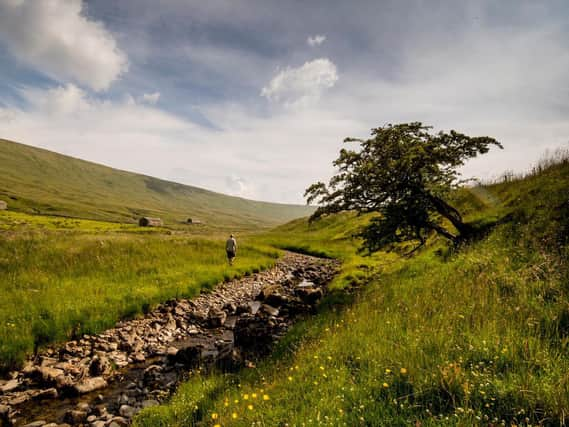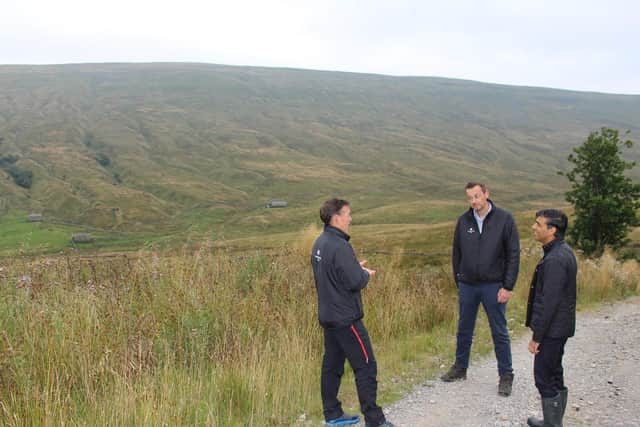The Woodland Trust plans to create 'jewel in the crown' of the Northern Forest and give native red squirrels numbers a boost on its new land at Snaizeholme


The trust aims to plant around 250,000 trees on the landscape south-west of Hawes as part of a “mosaic” of habitat restoration which it said will benefit wildlife and lock up carbon to fight climate change.
When completed it will be one of the largest new woodlands within the Yorkshire Dales National Park and a major element of the Northern Forest – a project which has already seen 3.5 million trees planted across the North of England since 2018/19.
Advertisement
Hide AdAdvertisement
Hide AdFunding for the land purchase in Upper Wensleydale has come from a number of sources including the Woodland Trust’s public £3.5m Snaizeholme Appeal.


The cost of planting the trees and other works is expected to be covered by the Woodland Trust and Forestry Commission grants.
The land sits alongside the existing red squirrel reserve and trail at Snaizeholme and it is hoped the forest project will help boost the numbers of this endangered native species even further.
Alistair Nash, the Woodland Trust’s estate manager for Snaizeholme, said: “Our vision is to extend and protect the existing red squirrel reserve. We’ll link and buffer neighbouring woodland – patches of which we suspect are ancient.
Advertisement
Hide AdAdvertisement
Hide Ad“The tree-planting and habitat work is a golden opportunity to boost biodiversity. Trees will improve the water quality of the waterways, safeguarding otters and white-clawed crayfish, plus birds such as herons, grey wagtails, kingfishers and dippers.”
Staff from the Woodland Trust showed Chancellor and Richmond MP Rishi Sunak their plans during a walk through the newly purchased landscape, the majority of which is currently bare moorland.
“This is a quite amazing project taking shape in the heart of the Dales which will have so many long-term benefits for the immediate area and the wider environment and economy of the North of England,” Mr Sunak said.
“The planting of so many trees will really boost our efforts to tackle climate change, improve bio-diversity for wildlife and also help to combat flooding in other parts of Yorkshire.”
Advertisement
Hide AdAdvertisement
Hide AdRepairs to dry stone walls which not only mark the landscape’s character but provide corridors and shelter for wildlife are also included in the plans, along with ‘slow the flow measures’.
Leaky stone dams built in stream channels will fight flooding, trap sediment and reduce land erosion while letting fish and crayfish safely slip through.
The Woodland Trust announced in July it would end the use of new plastic tree guards at its sites by the end of the year in a bid to make tree planting more sustainable and newly-planted saplings would be protected from damage by deer and rabbits by using plastic-free guards.
Mr Nash said the aim was to create approximately 65 per cent woodland cover – a mixture of native broadleaved trees, including oak, birch rowan, alder and willows, which would form an “irregular woodland” across the mid slopes of the valley, avoiding planting close to existing streams, stream gullies and wet flushes.
Advertisement
Hide AdAdvertisement
Hide AdScots pine would form a “significant percentage” to landscape in the edges of the existing spruce plantations, providing habitat and foraging at an early stage for some of the priority species such as red squirrel and black grouse.
Mr Nash explained that an area of heavily degraded blanket bog criss-crossed with old drainage channels, but with developing heather, bilberry, cranberry and patches of sphagnum would remain unplanted.
This, he said, would ideally develop naturally, providing nesting and foraging habitat for upland birds. However, he added, if necessary, works would be undertaken to ‘re-wet’ the peat.
“The open valley bottoms offer potential for wading birds such as curlew, lapwing, oystercatcher and snipe by retaining very open mixed grassland.”
Advertisement
Hide AdAdvertisement
Hide AdPockets of scrub and dappled shade will be created along the river by scattered trees – especially on the riverside slopes.
The river will be allowed to flood with some stone leaky dams being built into the feeder tributaries to slow water flow and reduce flooding peaks.
Barns would be kept as features in the valley and meadows ideally maintained by cattle grazing.
The Woodland Trust would like to hear public comments and ideas on the Snaizeholme project.
Advertisement
Hide AdAdvertisement
Hide AdIt is holding a ‘pop-in’ public consultation event today, Saturday, October 23 and tomorrow, Sunday, October 24 between 10am-4pm at the meeting room at the Dales Countryside Museum in Hawes or fill in the consultation form at woodlandtrust.org.uk
What is the Northern Forest?
The Northern Forest is part of the Government’s 25-year Environment Plan.
It will see 50 million trees planted over the next 25 years from Liverpool to Hull.
It has been backed by an initial government investment of almost £6m.
Advertisement
Hide AdAdvertisement
Hide AdThe Northern Forest will span more than 120 miles between the cities of Bradford, Leeds, Manchester and Liverpool and cover North Yorkshire.
The Northern Forest will help boost habitats for woodland birds and bats and protect iconic species such as the red squirrel – alongside providing a green space for people.